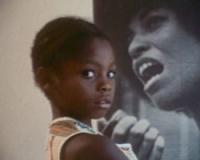At tonight’s Q&A session after the films, Zeinabu irene Davis voiced her frustration with her students’ tendency to undervalue the experience of seeing a film in a theater with an audience. She lamented one student’s choice to watch Daughters of the Dust on her mobile phone; besides the inability of the tiny screen to deliver the full audiovisual experience of the powerful film, Davis insisted these pieces need to be watched in a theater as part of a viewing community.

Tonight’s screening emphasized this very fact. Davis’ short Cycles centers around a young woman’s nervous wait for her overdue period, and the soundtrack during the film’s credits consists of multiple female voices reporting the foods they crave most while menstruating. Women in the audience laughed, murmured their agreement to certain foods, or even cringed audibly (when one voice in the credits admitted a craving for peanut butter, mayonnaise and lettuce sandwiches).
O. Funmilayo Makarah’s L.A. in my Mind provoked similar audience responses: this film features text graphics floating over footage of Los Angeles passing by a car window, what discussion moderator Jacqueline Stewart called a “roll call” of significant people and places in Makarah’s life. Makarah described this film as very personal, meant as a record for her own memories and essentially intended for her own consumption. Yet audience members keyed into this piece’s exploration of L.A., calling out and applauding in response to L.A. icons that resonated with them. In this way, even when watching these films in a shared group setting, each person in the audience could experience and express a very personal connection to these artists’ work.
—Bryan Wuest






 Mobile Navigation
Mobile Navigation


Comments